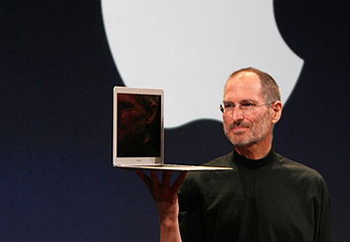Apple co-founder and CEO Steve Jobs is considered one of the most astonishing presenters on the world stage. For more than three decades, he has transformed presentations into awe-inspiring experiences. Jobs acts as a preacher in many ways, rallying the Mac faithful and encouraging “non-believers” to join the Apple community. If you were to watch hundreds of hours of his presentations -- as I have -- you would notice some consistent similarities between Jobs’ astonishing presentations and an inspiring sermon. Although few Christian leaders have the multimedia firepower Jobs commands, I’m convinced that anyone who speaks to an audience can learn from him. After researching my book on Jobs’ speaking style, I’ve distilled seven principles of a Jobs presentation:
Set the theme. Jobs sets the stage for 90-minute keynotes by introducing the theme of his presentation. “Today is all about music,” he once said before unveiling new iTunes software and a new iPod model. In January 2007, shortly after he took the stage to introduce the iPhone for the first time, Jobs told the audience: “Today Apple is going to reinvent the phone.” Your audience craves meaning before detail. Start with the big picture.
Tell personal stories. Jobs appreciates the power of story and uses stories frequently in his speeches and presentations. In his now-famous 2005 Stanford Commencement address, Jobs told the graduates three stories from his life. Each story connected to a different theme that he used to open the anecdote. For example, the first story was about “connecting the dots.” Jobs talked about dropping out of college so he could take courses he was genuinely interested in, like calligraphy. By following his curiosity, he learned about things that would become invaluable to him later in life (the original Macintosh was the first computer to incorporate beautiful typography). You’re surrounded by stories. Tell more of them.
Introduce the antagonist. Good vs. evil is a common storyline. Introducing an enemy (sin, temptation, etc.) serves to rally listeners around the ultimate hero -- God. Like a great preacher, Jobs incorporates the hero/villain narrative into his presentations. For example, when he first introduced Macintosh in 1984, he painted the picture of an enemy -- IBM -- that, in Jobs’ words, was bent on dominating the entire computer industry. Apple, he argued, was the last line of defense to save the creative people who didn’t want their souls taken over by the impersonal giant. In sermons and presentations, create a compelling narrative complete with heroes and villains.
Strive for simplicity. A Jobs presentation is strikingly simple. For example, the average PowerPoint slide contains 40 words. It’s difficult to find 40 words in 10 slides in a typical Jobs presentation. Most of his slides contain images and photographs. This is called “picture superiority.” When it comes to retaining information, people process information more effectively when it is presented as words and pictures instead of words alone. Some studies have suggested that when information is delivered verbally, people will remember about 10 percent of what they hear. When photographs are added to that same information, retention rates soared to 60 percent. The lesson here is to use more photographs and fewer words when giving a presentation.
Create a water-cooler moment. Great sermons often have one moment when the audience sees how the stories fit together in one big lesson. The same holds true for a Jobs presentation. Scripted into every presentation is one moment that everybody will talk about the next day. For example, in January 2007, Jobs told the audience that Apple was going to introduce three revolutionary products -- a new iPod, a phone and an Internet communications device. He repeated the list of products several times until finally he said, “Aren’t you getting it? These are not three separate devices. This is one device!” The audience roared with delight. Ask yourself, what is the one moment in my presentation or sermon that my audience or congregation will talk about long after it’s over?
Develop command presence. Captivate the audience by matching your words with powerful body language. Jobs does three things to engage the audience. First, he maintains eye contact 90 percent of the time. He rarely reads from notes. Secondly, he never erects a barrier between himself and the audience by standing behind a lectern. Finally, he frequently uses hand gestures. Make sure your body language is as engaging as your story.
Practice, practice and practice some more. All great speakers practice. Jobs makes it look effortless because he rehearses relentlessly. He doesn’t need notes because he knows exactly what he’s going to say next. He spends hours and hours over many weeks rehearsing each segment of the presentation. You might have compelling content but it will fall short if you don’t stand up and practice -- out loud.
Whether you are looking to improve your sermons or your presentations to a board of trustees, you can improve by using some of Jobs’ effective techniques.







